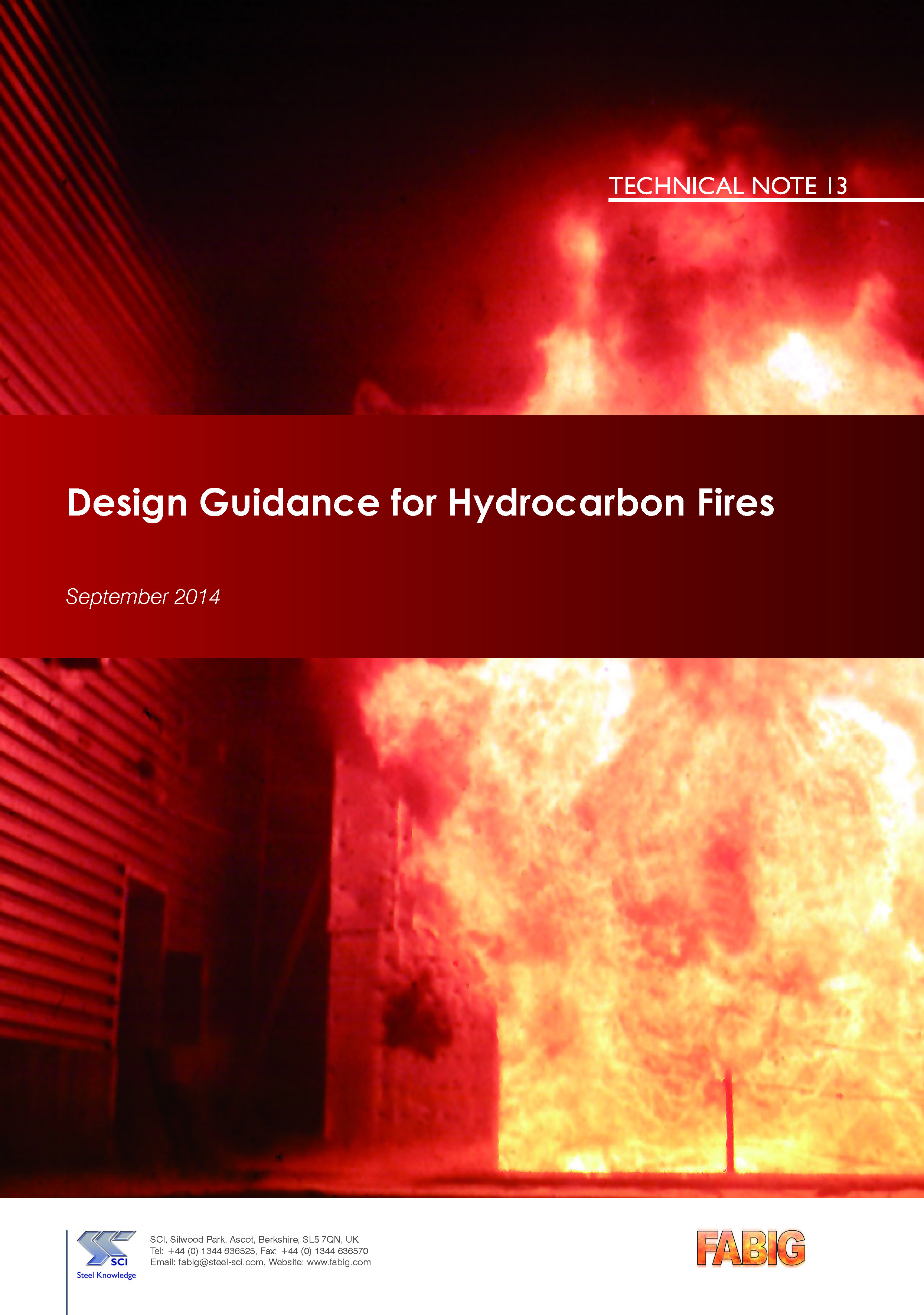Technical Note 13
Design Guidance for Hydrocarbon Fires

FABIG Members: Log-in to access all FABIG resources LOG IN
SUMMARY
This Technical Note updates and brings together into a single source the available guidance on fire loading and structural response in fire. In addition, new tabulated guidance on the effect of confinement on jet fires has been included and new elevated temperature material data for certain high strength steels and stainless steels have been added. This document therefore now supersedes Section 4 of the original Interim Guidance Notes, Technical Note 1, Section 3 of Technical Note 6 and Technical Note 11.
- Section 2 describes the range of possible fire scenarios, the parameters that affect the nature of these scenarios, possible locations of fire hazards on offshore structures and provides guidance on fire hazard management strategies;
- Section 3 covers hydrocarbon pool fires, giving simplified guidance on estimating fire loads for design;
- Section 4 covers hydrocarbon jet fires, giving simplified guidance on estimating fire loads for design;
- Section 5 gives guidance on heat transfer and temperature development in steel members;
- Section 6 summarises general principles of passive fire protection, noting key standards;
- Section 7 discusses active mitigation systems and their effect on pool and jet fires;
- Sections 8 and 9 describe the Eurocode basis of design and the process for determining the fire resistance of structural steel members in accordance with Eurocode 3;
- Appendix A describes a probabilistic approach for determining offshore fire loads;
- Appendix B gives properties of carbon and stainless steel at elevated temperatures;
- Appendix C gives a range of design examples to illustrate the calculation of heat transfer and temperature rise as well as the application of the Eurocode.
TABLE OF CONTENTS
- INTRODUCTION
- Background
- Scope
- FIRE SCENARIOS AND FIRE HAZARD MANAGEMENT
- Event parameters
- Fuel types
- Platform inventories
- Releases
- Fire hazard location
- Fire hazard management
- POOL FIRES
- Nature and characteristics
- Effect of confinement (Compartment Pool fires)
- Measurement of heat loads from pool fires to engulfed objects
- Methanol pool fires
- LNG pool fires
- Pool fires on the sea
- Tabulated guidance
- JET FIRES
- Gas jet fires - nature and characteristics
- Effect of confinement on gas jet fires (Compartment gas jet fires)
- Thermal load to engulfed objects from gas jet fires
- Tabulated guidance
- Liquid jet fires - Nature and characteristics
- Effect of confinement on liquid jet fires (compartment liquid jet fires)
- Thermal loads to engulfed objects from two phase jet fires
- Tabulated guidance for two phase jet fires
- HEAT TRANSFER AND TEMPERATURE DEVELOPMENT
- Introduction
- Predictive modelling
- Heat transfer to non-engulfed objects
- Temperature rise of non-engulfed objects
- Heat transfer to and temperature rise of engulfed objects
- Heat transfer by attachments to protected structural steelwork
- PASSIVE FIRE PROTECTION
- Objectives of passive fire protection (PFP)
- Passive fire protection systems
- Testing and classification of PFP systems
- PFP performance standards
- Coatback of secondary and tertiary attachments
- ACTIVE FIRE PROTECTION
- General
- Effect of water deluge on pool fires
- Effect of water deluge on jet fires
- Variations on traditional deluge systems
- Large bore deluge nozzles
- Vulnerability to explosion
- Hoses and monitors
- Foam systems
- Water sprays and mist systems
- DIFFS system
- Gaseous systems
- Chemical fire suppression systems
- EUROCODE APPROACH TO FIRE RESISTANT DESIGN
- Designing with the Eurocodes
- Verification by partial factor method
- Scope of Eurocode for structural fire design of steel structures
- Fire design procedures in the Eurocodes
- Verification of member resistances in fire
- EUROCODE SIMPLE DESIGN RULES FOR STRUCTURAL STEEL MEMBERS IN FIRE
- Section classification
- Critical temperature method
- Design resistances of structural members
- Resistance of tension members
- Resistance of compression members
- Resistance of restrained beams
- Lateral torsional buckling resistance
- Members subject to combined bending and axial compression
- Members with Class 4 cross sections
- Stainless steel members
- Design resistance of joints
- REFERENCES
- APPENDIX A PROBABILISTIC ASSESSMENT OF FIRE LOADS AND STRUCTURAL RESPONSE
- APPENDIX B PROPERTIES OF STEEL AT ELEVATED TEMPERATURE
- APPENDIX C DESIGN EXAMPLES
- Heating of steel remote from fire source
- Heat flux variation with location relative to fire
- Heat conduction along a member
- Design of a steel beam in fire using the critical temperature method
- Design of a steel column in fire using the reduced resistance method
Online purchase options:
Non-Members of FABIG are able to purchase PDF copies of the FABIG Technical Guidance documents.